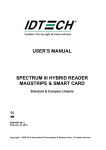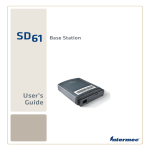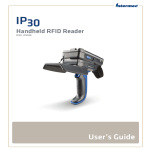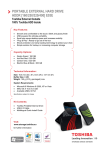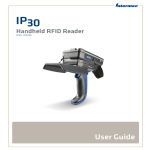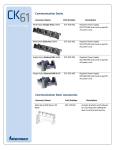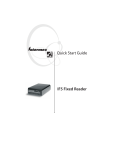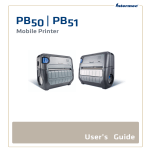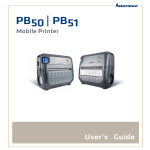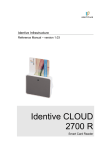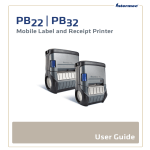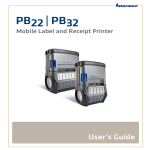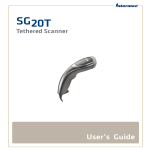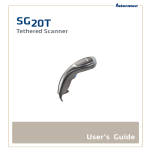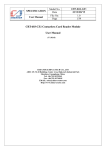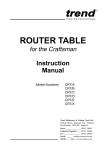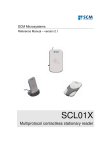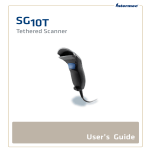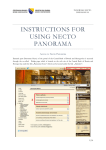Download PW50 Workboard Printer User`s Guide
Transcript
PW50 Workboard Printer User’s Guide Intermec Technologies Corporation Worldwide Headquarters 6001 36th Ave.W. Everett, WA 98203 U.S.A. www.intermec.com The information contained herein is provided solely for the purpose of allowing customers to operate and service Intermec-manufactured equipment and is not to be released, reproduced, or used for any other purpose without written permission of Intermec Technologies Corporation. Information and specifications contained in this document are subject to change without prior notice and do not represent a commitment on the part of Intermec Technologies Corporation. © 2008–2011 by Intermec Technologies Corporation. All rights reserved. The word Intermec, the Intermec logo, Norand, ArciTech, Beverage Routebook, CrossBar, dcBrowser, Duratherm, EasyADC, EasyCoder, EasySet, Fingerprint, i-gistics, INCA (under license), Intellitag, Intellitag Gen2, JANUS, LabelShop, MobileLAN, Picolink, Ready-to-Work, RoutePower, Sabre, ScanPlus, ShopScan, Smart Mobile Computing, SmartSystems, TE 2000, Trakker Antares, and Vista Powered are either trademarks or registered trademarks of Intermec Technologies Corporation. There are U.S. and foreign patents as well as U.S. and foreign patents pending. ii PW50 Workboard Printer User’s Guide Document Change Record This page records changes to this document. The document was originally released as Revision 001. Version Number Date Description of Change 003 5/2011 Added information on the testfeed and testprint functions, cleaning pen and cleaning swab accessories, and default error conditions. 002 7/2009 Revised to add information about using the PW50 smart card reader with the CN3 or CK61 mobile computer. PW50 Workboard Printer User’s Guide iii iv PW50 Workboard Printer User’s Guide Contents Contents Before You Begin. . . . . . . . . . . . . . . . . . . . . . . . . . . . . . . . . . . . . . . . . . . . . . . . . . . . . . . . . . . . . . . . . vii Safety Information . . . . . . . . . . . . . . . . . . . . . . . . . . . . . . . . . . . . . . . . . . . . . . . . . . . . . . . vii Global Services and Support . . . . . . . . . . . . . . . . . . . . . . . . . . . . . . . . . . . . . . . . . . . . . . vii Warranty Information. . . . . . . . . . . . . . . . . . . . . . . . . . . . . . . . . . . . . . . . . . . . vii Web Support . . . . . . . . . . . . . . . . . . . . . . . . . . . . . . . . . . . . . . . . . . . . . . . . . . . viii Telephone Support . . . . . . . . . . . . . . . . . . . . . . . . . . . . . . . . . . . . . . . . . . . . . viii Service Location Support . . . . . . . . . . . . . . . . . . . . . . . . . . . . . . . . . . . . . . . . viii Who Should Read This Manual . . . . . . . . . . . . . . . . . . . . . . . . . . . . . . . . . . . . . . . . . . . ix Related Documents . . . . . . . . . . . . . . . . . . . . . . . . . . . . . . . . . . . . . . . . . . . . . . . . . . . . . . ix 1 Using the PW50 Workboard Printer ................................... 1 Learning About the PW50 Workboard Printer . . . . . . . . . . . . . . . . . . . . . . . . . . . . . . . . . . . . . . . 2 Identifying the Parts of the Printer . . . . . . . . . . . . . . . . . . . . . . . . . . . . . . . . . . . . . . . . . 2 Understanding the Ports and Optional Card Reader . . . . . . . . . . . . . . . . . . . . . . . . . 3 Understanding the Control Panel . . . . . . . . . . . . . . . . . . . . . . . . . . . . . . . . . . . . . . . . . . 4 Understanding the Printer Sounds . . . . . . . . . . . . . . . . . . . . . . . . . . . . . . . . . . . . . . . . . 5 Using the Batteries . . . . . . . . . . . . . . . . . . . . . . . . . . . . . . . . . . . . . . . . . . . . . . . . . . . . . . . . . . . . . . . . 5 Installing the Battery . . . . . . . . . . . . . . . . . . . . . . . . . . . . . . . . . . . . . . . . . . . . . . . . . . . . . . 7 Charging the Batteries. . . . . . . . . . . . . . . . . . . . . . . . . . . . . . . . . . . . . . . . . . . . . . . . . . . . . 8 Extending Battery Life. . . . . . . . . . . . . . . . . . . . . . . . . . . . . . . . . . . . . . . . . . . . . . . . . . . . . 8 Loading Media. . . . . . . . . . . . . . . . . . . . . . . . . . . . . . . . . . . . . . . . . . . . . . . . . . . . . . . . . . . . . . . . . . . . 9 Printing a Testprint . . . . . . . . . . . . . . . . . . . . . . . . . . . . . . . . . . . . . . . . . . . . . . . . . . . . . . . . . . . . . . 11 Inserting a Mobile Computer . . . . . . . . . . . . . . . . . . . . . . . . . . . . . . . . . . . . . . . . . . . . . . . . . . . . . 12 2 Configuring the PW50 . . . . . . . . . . . . . . . . . . . . . . . . . . . . . . . . . . . . . . . . . . . . . . . . . 13 Configuring the PW50 . . . . . . . . . . . . . . . . . . . . . . . . . . . . . . . . . . . . . . . . . . . . . . . . . . . . . . . . . . . 14 Establishing Communications With a Host . . . . . . . . . . . . . . . . . . . . . . . . . . . . . . . . . . . . . . . . 14 Setting Up Bluetooth Communications. . . . . . . . . . . . . . . . . . . . . . . . . . . . . . . . . . . . 14 Setting Up Serial Communications . . . . . . . . . . . . . . . . . . . . . . . . . . . . . . . . . . . . . . . . 16 Communicating with the Smart Card Reader. . . . . . . . . . . . . . . . . . . . . . . . . . . . . . . . . . . . . . . 17 Downloading Fonts and Graphics . . . . . . . . . . . . . . . . . . . . . . . . . . . . . . . . . . . . . . . . . . . . . . . . . 18 PW50 Workboard Printer User’s Guide v Contents Upgrading the Firmware. . . . . . . . . . . . . . . . . . . . . . . . . . . . . . . . . . . . . . . . . . . . . . . . . . . . . . . . . . 19 Understanding the Printer Modes . . . . . . . . . . . . . . . . . . . . . . . . . . . . . . . . . . . . . . . . . . . . . . . . . 20 Understanding Ready Mode . . . . . . . . . . . . . . . . . . . . . . . . . . . . . . . . . . . . . . . . . . . . . . 20 Understanding Pause Mode. . . . . . . . . . . . . . . . . . . . . . . . . . . . . . . . . . . . . . . . . . . . . . . 20 Understanding Error Mode . . . . . . . . . . . . . . . . . . . . . . . . . . . . . . . . . . . . . . . . . . . . . . . 20 Understanding Test Mode . . . . . . . . . . . . . . . . . . . . . . . . . . . . . . . . . . . . . . . . . . . . . . . . 20 Using Test Mode. . . . . . . . . . . . . . . . . . . . . . . . . . . . . . . . . . . . . . . . . . . . . . . . . 21 Using Extended Test Mode . . . . . . . . . . . . . . . . . . . . . . . . . . . . . . . . . . . . . . . 22 Understanding Upgrade Mode . . . . . . . . . . . . . . . . . . . . . . . . . . . . . . . . . . . . . . . . . . . . 23 3 Troubleshooting and Maintaining the PW50 . . . . . . . . . . . . . . . . . . . . . . . 25 Troubleshooting the PW50 . . . . . . . . . . . . . . . . . . . . . . . . . . . . . . . . . . . . . . . . . . . . . . . . . . . . . . . 26 Contacting Product Support. . . . . . . . . . . . . . . . . . . . . . . . . . . . . . . . . . . . . . . . . . . . . . 26 Understanding Error Messages . . . . . . . . . . . . . . . . . . . . . . . . . . . . . . . . . . . . . . . . . . . . 27 Troubleshooting Printer Problems and Finding Solutions . . . . . . . . . . . . . . . . . . . 27 Troubleshooting Communication Problems . . . . . . . . . . . . . . . . . . . . . . . . . . . . . . . 29 Cold Booting the PW50 . . . . . . . . . . . . . . . . . . . . . . . . . . . . . . . . . . . . . . . . . . . . . . . . . . . . . . . . . . 29 Cleaning the PW50. . . . . . . . . . . . . . . . . . . . . . . . . . . . . . . . . . . . . . . . . . . . . . . . . . . . . . . . . . . . . . . 30 A Specifications . . . . . . . . . . . . . . . . . . . . . . . . . . . . . . . . . . . . . . . . . . . . . . . . . . . . . . . . . 33 Specifications. . . . . . . . . . . . . . . . . . . . . . . . . . . . . . . . . . . . . . . . . . . . . . . . . . . . . . . . . . . . . . . . . . . . 34 Accessories for the PW50 . . . . . . . . . . . . . . . . . . . . . . . . . . . . . . . . . . . . . . . . . . . . . . . . . . . . . . . . . 37 vi PW50 Workboard Printer User’s Guide Before You Begin Before You Begin This section provides you with safety information, technical support information, and sources for additional product information. Safety Information Your safety is extremely important. Read and follow all warnings and cautions in this document before handling and operating Intermec equipment. You can be seriously injured, and equipment and data can be damaged if you do not follow the safety warnings and cautions. This section explains how to identify and understand warnings, cautions, and notes that are in this document. A warning alerts you of an operating procedure, practice, condition, or statement that must be strictly observed to avoid death or serious injury to the persons working on the equipment. A caution alerts you to an operating procedure, practice, condition, or statement that must be strictly observed to prevent equipment damage or destruction, or corruption or loss of data. Note: Notes either provide extra information about a topic or contain special instructions for handling a particular condition or set of circumstances. Global Services and Support Warranty Information To understand the warranty for your Intermec product, visit the Intermec web site at www.intermec.com and click Support > Returns and Repairs > Warranty. PW50 Workboard Printer User’s Guide vii Before You Begin Disclaimer of warranties: The sample code included in this document is presented for reference only. The code does not necessarily represent complete, tested programs. The code is provided “as is with all faults.” All warranties are expressly disclaimed, including the implied warranties of merchantability and fitness for a particular purpose. Web Support Visit the Intermec web site at www.intermec.com to download our current manuals (in PDF). Visit the Intermec technical knowledge base (Knowledge Central) at www.intermec.com and click Support > Knowledge Central to review technical information or to request technical support for your Intermec product. Telephone Support In the U.S.A. and Canada, call 1-800-755-5505. Outside the U.S.A. and Canada, contact your local Intermec representative. To search for your local representative, from the Intermec web site, click About Us > Contact Us. Service Location Support For the most current listing of service locations, click Support > Returns and Repairs > Repair Locations. For technical support in South Korea, use the after service locations listed below: AWOO Systems 102-1304 SK Ventium 522 Dangjung-dong Gunpo-si, Gyeonggi-do Korea, South 435-776 Contact: Mr. Sinbum Kang Telephone: +82-31-436-1191 Email: [email protected] viii PW50 Workboard Printer User’s Guide Before You Begin IN Information System PTD LTD 6th Floor Daegu Venture Center Bldg 95 Shinchun 3 Dong Donggu, Daegu City, Korea E-mail: [email protected] or [email protected] Who Should Read This Manual This user’s guide is for the person who is responsible for installing, configuring, and maintaining the PW50 Workboard Printer. This user’s guide provides you with information about the features of the PW50, and how to configure, operate, maintain, and troubleshoot it. Before you work with the PW50, you should be familiar with your network and general networking terms, such as IP address. Related Documents The Intermec web site at www.intermec.com contains our documents (as .pdf files) that you can download for free. To download documents 1 Visit the Intermec web site at www.intermec.com. 2 Click the Products tab. 3 Using the Products menu, navigate to your product page. For example, to find the PW50 printer product page, click Printers and Media > Mobile Printers > PW50. 4 Click the Manuals tab. If your product does not have its own product page, click Support > Manuals. Use the Product Category field, the Product Family field, and the Product field to help you locate the documentation for your product. PW50 Workboard Printer User’s Guide ix Before You Begin x PW50 Workboard Printer User’s Guide 1 Using the PW50 Workboard Printer Use this chapter to familiarize yourself with the PW50 Workboard Printer. This chapter contains these sections: • Learning About the PW50 Workboard Printer • Using the Batteries • Loading Media • Printing a Testprint • Inserting a Mobile Computer 1 Chapter 1 — Using the PW50 Workboard Printer Learning About the PW50 Workboard Printer The PW50 is a rugged direct thermal receipt printer that is designed for use with these Intermec mobile computers: • CN3 and CN3e • CK61 and CK61ex The PW50 provides: • print resolution of 203 dpi. • print speeds of up to 100 mm per second (4 ips). • a Bluetooth radio. Before you can use a new printer, or a printer that you reset to factory default settings, you must perform a testfeed. Identifying the Parts of the Printer Use this illustration to familiarize yourself with some of the features of the PW50. Card reader (optional) Feed button Standby button Battery Printer ports Intermec Ready-to-Work indicator Media cover release button Status Communications PW50 Printer: This illustration shows the important features of the PW50 printer. A weather-resistant flap protects the communications ports and the external power connector. 2 PW50 Workboard Printer User’s Guide Chapter 1 — Using the PW50 Workboard Printer Understanding the Ports and Optional Card Reader The PW50 ports are located on the bottom of the printer. Power connector COM1 DEX USB PW50 Ports: Use this illustration to familiarize yourself with the PW50 ports. PW50 Port Descriptions Port Description USB Allows USB devices to connect to the PW50. Note: USB communications are not currently enabled on the PW50. For more information, contact your Intermec sales representative. COM1 Allows RS-232 devices, such as PCs, to connect to the PW50. Power connector Connects the PW50 to an AC power supply. DEX Provides support for DEX/UCS (Direct Exchange/ Uniform Communication Standard). The DEX port allows two-way electronic transfer of invoice information between a vendor’s mobile computer inserted in the PW50 and a store’s inventory system. Card reader (optional) Reads magstripe cards and smart cards. Note: To use the DEX port or the card reader, you must insert a mobile computer into the PW50. PW50 Workboard Printer User’s Guide 3 Chapter 1 — Using the PW50 Workboard Printer Understanding the Control Panel The PW50 control panel contains two buttons and four LED indicators. Use the two buttons to perform functions on the PW50 printer. Note: The Intermec Ready-to-Work™ indicator and the Status LED also indicate the status of the printer modes. For more information, see “Understanding the Printer Modes” on page 20. Standby button Feed button Communications Status Battery Intermec Ready-to-Work indicator PW50 Control Panel: Use this illustration to familiarize yourself with the buttons and LEDs on the PW50. Understanding How to Use the PW50 Buttons Button Name Functions Standby Press to put the printer in Standby mode. In Standby (Power) mode, power to the radio and all communications ports (USB, COM1, and Bluetooth) are turned off. Press to turn the printer back on and put the printer in Ready mode. Press and hold for more than 2 seconds to enable or disable Bluetooth communications. 4 PW50 Workboard Printer User’s Guide Chapter 1 — Using the PW50 Workboard Printer Understanding How to Use the PW50 Buttons (continued) Button Name Functions Feed Press to advance receipt paper. The amount of media that feeds depends on the type of media you are using. Media advances by 5 mm (0.2 in) or feeds a configured length of media based on your media and settings. If the printer is printing, pressing this button pauses printing. Press the button again to resume printing. Press and hold the Feed button for 3 seconds to perform a testfeed and register new media. Understanding the Printer Sounds The PW50 plays sounds in response to several actions that you can take with the printer. Use the following table to understand when the sounds occur and what they mean. Understanding the Printer Sounds Sound Occurs When: Power • You insert a battery in the printer. • The PW50 starts charging the battery. • You plug in the AC adapter. Hardware You open the media door, close the media door, or insert a cable. Button You press one of the PW50 buttons. Error • The printer cannot feed paper or print a job because of a hardware issue such as the media door open, a paper jam, or there is no media. • An error occurs such as a paper jam, a print error, or the printer is out of range. Using the Batteries The PW50 uses a rechargeable 2200 mAh lithium-ion battery (Model AB13) for power. You must fully charge the battery before you can use the PW50. A fully charged battery can last up to one week without needing to be recharged when the printer is in Standby mode. PW50 Workboard Printer User’s Guide 5 Chapter 1 — Using the PW50 Workboard Printer Use only Intermec battery pack Model AB13. Use of incorrect battery may present a risk of fire or explosion. Promptly dispose of used battery pack according to the instructions. The Model AB13 battery may ignite, create a chemical burn hazard, explode, or release toxic materials if mistreated. Do not incinerate, disassemble, or heat above 100°C (212°F). Do not short circuit; may cause burns. Keep away from children. 6 PW50 Workboard Printer User’s Guide Chapter 1 — Using the PW50 Workboard Printer Installing the Battery Make sure you fully charge the battery before you use your PW50. You can charge the battery before or after you install it in the PW50. To install the battery 1 Lay the PW50 upside down on a flat surface. 2 Insert the battery with the tab facing away from the front control panel. 3 Insert the edge of the battery under the lip of the PW50 and then push down until you hear the battery latch click. PW50 Workboard Printer User’s Guide 7 Chapter 1 — Using the PW50 Workboard Printer Charging the Batteries There are two ways to charge the PW50 battery: • Connect power to the printer while the battery is installed. • Use the AC18 4-bay battery charger. For information on charging your battery in the 4-bay battery charger, see the AC18 4-Bay Battery Charger Instructions. It takes approximately 6 hours to charge the battery while it is installed in the PW50 printer. To charge the battery inside the PW50, you need these items: • Intermec 12 VDC power supply (Model AE19) • AC power cord To charge the battery inside the PW50 1 Install the battery in the PW50. For help, see the previous section, “Installing the Battery.” 2 Connect the power supply to the power connector on the printer. 3 Connect one end of the power cord to the power supply, and then plug the other end into an AC outlet. Extending Battery Life Here are some tips for extending the overall life of your battery: • Never expose the battery to direct sunlight or temperatures over 40°C (104°F). • Only charge the battery inside the PW50 using a power supply or in the 4-bay battery charger (Model AC18). Here are some tips for extending the life of your battery between charges: 8 • Press the Standby button to put the printer in Standby mode. • Remove the battery from the printer if you are not going to use it for three or more days. • Do not operate the PW50 in extremely cold temperatures. Using the PW50 in temperatures below freezing reduces the overall battery life. PW50 Workboard Printer User’s Guide Chapter 1 — Using the PW50 Workboard Printer Remember that any rechargeable battery loses its ability to maintain a charge over time. You can only recharge it a finite number of times before you must replace it. Loading Media You can use roll or fanfold receipt media with the PW50 printer. The PW50 ships with a small amount of media loaded and a test page printed to verify that the printer works. For information on media specifications, see “Specifications” on page 34. To load media 1 Press the blue media cover release button to open the cover. 2 Insert a roll of media. Make sure you load the media counterclockwise so that it pulls off the core from the bottom of the printer. 3 Pull out approximately 8 cm (3 in) of the media. PW50 Workboard Printer User’s Guide 9 Chapter 1 — Using the PW50 Workboard Printer 4 Close the media cover. 5 Press down on the cover until it latches. The printer emits the hardware sound to tell you that the media door closed correctly. 6 Press the Feed button to advance the media. Before you can use a new printer, or a printer that you reset to factory default settings, you must perform a testfeed. 10 PW50 Workboard Printer User’s Guide Chapter 1 — Using the PW50 Workboard Printer Printing a Testprint After you load media in the printer, you are ready to print a testprint. If you cannot get the testprint information to print, see Chapter 3, “Troubleshooting and Maintaining the PW50.” To print a testprint 1 Make sure the PW50 is in Standby mode and is loaded with media. 2 Press and hold the Standby and Feed buttons until the PW50 beeps. 3 Release the buttons. 4 The PW50 prints a testprint and starts Test Mode. For more information, see “Understanding Test Mode” on page 20. PW50 Workboard Printer User’s Guide 11 Chapter 1 — Using the PW50 Workboard Printer Inserting a Mobile Computer The PW50 is designed for use with the CN3, CN3e, CK61, and CK61ex mobile computers. To insert a mobile computer • Slide the computer into the slot on the PW50 until the computer snaps into place. This illustration shows inserting a CN3. However, the PW50 is also designed for use with the CN3e, CK61, and CK61ex mobile computers. 12 PW50 Workboard Printer User’s Guide 2 Configuring the PW50 This chapter describes how to configure the PW50 and contains these sections: • Configuring the PW50 • Establishing Communications With a Host • Communicating with the Smart Card Reader • Downloading Fonts and Graphics • Upgrading the Firmware • Understanding the Printer Modes 13 Chapter 2 — Configuring the PW50 Configuring the PW50 To change the configuration settings of the PW50, you send commands from a host PC directly to the PW50 using a communications application and a serial connection. To configure the PW50 1 Set up serial communications between the PW50 and your host PC. For help, see “Setting Up Serial Communications” on page 16. 2 On your host PC, open a communications application, such as HyperTerminal. 3 Send ESC/P commands from your host PC to the PW50. For more information on how to change configuration settings, see the ESC/P Programmer’s Reference Manual. Establishing Communications With a Host The PW50 must establish communications with a host that will send the data for the printer to print. The PW50 can communicate with a host using one of these methods: • Bluetooth radio communications with a CN3, CN3e, CK61, or CK61ex mobile computer inserted in the PW50 • Serial communications through a serial cable Setting Up Bluetooth Communications The PW50 contains a Bluetooth radio that allows wireless communications with a remote device from distances up to 100 meters (approximately 328 feet) depending on the Bluetooth range capabilities of the remote device, environmental conditions, and obstructions. For the Bluetooth-enabled devices to exchange data, both devices must establish a connection. Bluetooth software is always running in the background. Note: To quickly enable or disable Bluetooth communications, press and hold the Standby button for more than 2 seconds. 14 PW50 Workboard Printer User’s Guide Chapter 2 — Configuring the PW50 The PW50 cannot initiate a Bluetooth connection. One of the devices, such as a CN3 mobile computer, must request a connection with the printer. The PW50 then accepts or rejects the connection. Use Intermec Settings on the mobile computer to enable the Bluetooth settings on the PW50. The PW50 can also connect to Bluetooth scanners such as the SF51 and the SR61. You can create the bar code labels you need to connect the printer to a Bluetooth scanner using EasySet software. If you are going to create the bar code labels using EasySet, you need to know the Bluetooth Device Address and the PIN of the PW50. You can download EasySet at no charge from the Intermec web site at www.intermec.com. Each PW50 equipped with a Bluetooth radio has a unique Bluetooth Device Address (BDA) loaded into its module when manufactured. You can find the BDA on the certification label located on the bottom of the printer. To set up Bluetooth communications with a mobile computer 1 Make sure that the PW50 is not connected to a serial cable. 2 Follow the procedure to discover and connect to Bluetooth devices in your mobile computer user’s manual. Note: The default passcode for the PW50 is “1234.” For maximum security, you need to configure a Bluetooth passcode for the PW50. For help, see the previous section, “Configuring the PW50” on page 14. PW50 Workboard Printer User’s Guide 15 Chapter 2 — Configuring the PW50 To set up Bluetooth communications with a scanner 1 Make sure that the PW50 is not connected to a serial cable. 2 Download and install EasySet on your host PC. 3 Create the following bar code labels using EasySet: • Administrator reset factory defaults • Bluetooth parameters - security - not active • Bluetooth parameters - connect/disconnect - compose BT address • Bluetooth parameters - security - compose PIN: 4 Scan the bar code labels with the Bluetooth scanner. Setting Up Serial Communications Before you can establish a serial connection, you need to make sure that the settings on the PC match the settings on the PW50. Serial Port Default Settings on the PW50 Parameter 16 Default Setting Baud rate 115200 Data bits 8 Parity None Stop bits 1 Flow control Hardware PW50 Workboard Printer User’s Guide Chapter 2 — Configuring the PW50 To connect the PW50 to a PC 1 Connect the 8-pin circular DIN connector on the serial cable (P/N 075497-001) to the serial port on the PW50. 2 Connect the other end of the serial cable to a serial port on the back of your PC. Serial cable Serial port Communicating with the Smart Card Reader The smart card reader on the PW50 supports communication with the CN3 and CK61 mobile computer. Before you can use the PW50 smart card reader with a mobile computer, you need to: • upgrade the CN3 or CK61 Windows Operating System (OS) and SmartSystems Platform Bundle (SSPB) to the latest versions. • insert the mobile computer into the PW50 docking port. • create a custom application that uses Microsoft APIs (application programming interface) to provide low-level interface calls to the reader. Here is a list of Microsoft APIs that are supported by the PW50 smart card reader: • SCardEstablishContext • SCardListReaders • SCardConnect PW50 Workboard Printer User’s Guide 17 Chapter 2 — Configuring the PW50 • SCardTransmit • SCardDisconnect • SCardReleaseContext Downloading Fonts and Graphics You can download fonts and graphics: • using PrintSet. You can download PrintSet from the downloads page for the PW50 printer on the Intermec web site at www.intermec.com. Follow the procedures in the PrintSet online help to download fonts and graphics. • using ESC/P commands to send files to the printer. For help with commands and information, see the ESC/P Programmer’s Reference Manual. • from your mobile computer using files available from the Intermec web site. You download a self-extracting cabinet file (.cab) to copy onto your mobile computer. When you double-click the .cab file, the mobile computer sends the files down to the PW50. To download fonts and graphics using the .cab file 1 Download the PW50 font, graphics, or firmware upgrade .zip file from the Intermec web site to your PC. 2 Unzip the file on your PC. 3 Use an application, such as ActiveSync™ to copy the .cab file onto the root directory of your mobile computer. 4 Double-click the .cab file on your mobile computer. 18 PW50 Workboard Printer User’s Guide Chapter 2 — Configuring the PW50 Upgrading the Firmware You can download firmware to your PW50 from a host PC using a serial connection. To upgrade your firmware, you need to send a .upg file to the PW50 that follows this format: PW50fxxxx_mmddyy.upg where: xxxx is the firmware version number. mm is the month of the firmware release. dd is the day of the firmware release. yy is the last two digits of the year of the firmware release. To upgrade your printer using a serial connection 1 Establish a serial connection between your PW50 and host PC. For help, see “Setting Up Serial Communications” on page 16. 2 Use ESC/P commands to send the upgrade file to the printer. For help with ESC/P commands, see the ESC/P Programmer’s Reference Manual. The PW50 starts the upgrade process. During the firmware upgrade, the Intermec Ready-to-Work indicator and the green status LED blink. The PW50 beeps when it is done with the upgrade. 3 Print a testprint to verify that your firmware was upgraded correctly. For help, see “Printing a Testprint” on page 11. 4 Cold boot the PW50. For help, see “Cold Booting the PW50” on page 29. PW50 Workboard Printer User’s Guide 19 Chapter 2 — Configuring the PW50 Understanding the Printer Modes The PW50 has five modes to help you effectively interact with the printer: Ready, Pause, Error, Test, and Upgrade. Use the following sections to understand the different printer modes. Understanding Ready Mode The printer is in Ready mode when the printer is on and ready to print. Understanding Pause Mode Use Pause mode to momentarily stop printing or to cancel a current print job. Use the Feed button to both pause and resume printing. To enter Pause mode • Press the Feed button while the printer is printing. To resume printing • Press the Feed button while the printer is paused. To cancel a print job 1 Press the Feed button to pause printing. 2 Press and hold the Feed button to cancel the print job. Understanding Error Mode The printer enters Error mode when it detects an error condition such as a low battery or a paper fault. When the printer is in Error mode, the status LED blinks red. Understanding Test Mode Use Test mode to verify printer settings, print testprints, restore factory default settings, or enter Dump mode for troubleshooting purposes. Two test modes are available: Test mode and Extended Test mode. 20 PW50 Workboard Printer User’s Guide Chapter 2 — Configuring the PW50 Using Test Mode Test mode consists of a sequence of events that requires very little interaction. Extended Test mode requires more interaction and lets you choose which actions you want the printer to perform. To enter Test mode 1 Make sure the PW50 is in Standby mode and is loaded with media. 2 Press and hold the Standby and Feed buttons until the PW50 beeps. 3 Release the buttons. The following sequence of events occurs. Test Mode Events Event Indicator 1 The printer is performing a test feed (sensor Status LED is steady red calibration), and media is continuously feeding as a series of testprints is printed. 2 The indicator blinks once for each testprint Intermec Ready-to-Work printed. 3 The printer entered Dump mode. While the printer is in Dump mode, it scans the communication ports. Any characters received on the communication ports are printed. indicator blinks Intermec Ready-to-Work indicator is on and status LED is steady red 4 Press Feed to exit Dump mode. When you exit Dump mode, the printer returns to Ready mode. PW50 Workboard Printer User’s Guide 21 Chapter 2 — Configuring the PW50 Using Extended Test Mode Use Extended Test mode to run additional diagnostic tests, including printing specific testprints, entering Dump mode, and resetting to factory defaults. To enter Extended Test mode 1 Make sure that the printer is loaded with media. 2 Press the media cover release button to open the media cover. 3 Press the Standby button to turn the printer off. 4 Press and hold the Standby and Feed buttons until the PW50 beeps. 5 Close the media cover. You are now in Extended Test mode. 6 Press the Standby button to cycle through the Extended Test mode options. While the PW50 is in Extended Test mode, the Intermec Ready-toWork indicator and the Status LED indicate the Extended Test mode option. Extended Test Mode Options Option Indicator Description Test Prints Intermec Ready-to-Work indicator is on Allows you to print testprints one at a time. Press the Feed button to print the next testprint. Dump Mode Intermec Ready-to-Work indicator is on and status LED is steady red Enters Dump mode. While the printer is in Dump mode, it scans the communication ports. Any characters received on the communication ports are printed. Press the Feed button to enter Dump mode, and press the Feed button again to exit Dump mode. Factory Default Status LED is steady green Restores the factory default settings. Exit 22 Intermec Ready-to-Work Exits Extended Test mode. indicator is on, status LED Press the Feed button to exit Extended Test mode. is steady red, and status LED is steady green PW50 Workboard Printer User’s Guide Chapter 2 — Configuring the PW50 To restore the factory default settings 1 Press the Feed button to enter Factory Default mode. The status light turns on steady red. 2 Press down on the blue media cover release button to open the media cover and confirm that you want to restore the factory default settings. The status light turns on steady green, the factory default settings are restored, and the PW50 reboots. 3 Close the media cover. 4 Perform a testfeed by holding down the Feed button until the PW50 beeps. Understanding Upgrade Mode The PW50 is in Upgrade mode while it is upgrading firmware. While the PW50 is in Upgrade mode, the Intermec Ready-to-Work indicator and the green status LED blink. For more information about upgrading firmware, see “Upgrading the Firmware” on page 19. PW50 Workboard Printer User’s Guide 23 Chapter 2 — Configuring the PW50 24 PW50 Workboard Printer User’s Guide 3 Troubleshooting and Maintaining the PW50 This chapter contains information to help you solve problems you may encounter while using the PW50 and contains these sections: • Troubleshooting the PW50 • Cold Booting the PW50 • Cleaning the PW50 25 Chapter 3 — Troubleshooting and Maintaining the PW50 Troubleshooting the PW50 You may have printer operation, print quality, or printer communication problems at some time during the life of the PW50 printer. It is easy to fix most of the problems and you will find solutions in “Troubleshooting Printer Problems and Finding Solutions” on page 27. If you cannot find the answer to your problem, you may need to contact Product Support. Contacting Product Support Before you call Intermec Product Support, you may want to visit the Intermec technical knowledge base (Knowledge Central) at intermec.custhelp.com to review technical information or to request technical support. If you still need help after visiting Knowledge Central, you may need to call Product Support. To talk to an Intermec Product Support representative in the U.S.A. or Canada, call: 1-800-755-5505 Outside the U.S.A. and Canada, go to www.intermec.com and click Contact to find your local Intermec representative. Before you call Intermec Product Support, make sure you have the following information ready: • Printer serial number • Firmware type and version • Bluetooth or serial port settings You can find all of the information listed above on a testprint page. For help, see “Printing a Testprint” on page 11. 26 PW50 Workboard Printer User’s Guide Chapter 3 — Troubleshooting and Maintaining the PW50 Understanding Error Messages Use the following tables to troubleshoot common errors. To receive error messages, you need to turn on the Allow Messages From Printer command. For help, see the ESC/P Programmer’s Reference Manual. PW50 Error Message Descriptions Error Message Description Lid_Open The media cover is open. Close the media cover and press down until it latches. If Lid_Open=Y, the printer detected an error condition and canceled any pending print jobs. Paper_Out The printer is out of media. Load a new roll of media. If Lid_Open=Y, the printer detected an error condition and canceled any pending print jobs. Voltage This message indicates the power status of the printer: • If Voltage=H, the printer is fully powered by either an external power supply or a fully charged battery. • If Voltage=L, the printer has detected a low voltage condition. Connect the printer to external power, or insert a fully charged battery. Troubleshooting Printer Problems and Finding Solutions Use the following tables to troubleshoot some common problems you may encounter with the PW50 printer. Printer Problems and Possible Solutions Problem Possible Solution Printer does not turn on when you press Standby. • Replace the battery with a charged battery. • Connect external power to make sure the printer The blue light (Intermec Ready-toWork™ indicator) is blinking. • Make sure that media is loaded, that you have PW50 Workboard Printer User’s Guide works correctly and to charge the battery. performed a testfeed, and that the media cover is closed. For more information, see “Loading Media” on page 9. • There is a printing error. • The printer is paused. The printer is canceling a print job. 27 Chapter 3 — Troubleshooting and Maintaining the PW50 Printer Problems and Possible Solutions (continued) Problem Possible Solution You press the Standby The printhead may be too hot. Wait until the button, but the printer printhead cools down and try again. does not enter Standby mode and the blue light (Intermec Readyto-Work indicator) starts blinking. You press and hold the The printhead may be too hot. Wait until the printhead cools down and try again. Standby button for more than 2 seconds to enable Bluetooth communications, but Bluetooth is not enabled. Printer keeps printing or feeding when it should stop. Check media settings. The printout is not in the desired position. Check for errors in the software application. The printer is not • Re-establish a Bluetooth connection with the printing with a mobile computer or scanner. For help, see Bluetooth connection. “Setting Up Bluetooth Communications” on page 14, or see your mobile computer user’s manual. • Make sure the mobile computer can print to a known good printer. • Print a Bluetooth testprint page to make sure that the mobile printer discovered your printer. For help, see “Printing a Testprint” on page 11. • Make sure the printer is in Ready mode. 28 When printing, the printer is skipping . Perform a testfeed by pressing the Feed button until the PW50 beeps. Printout is faded or weak. • Modify the Set Media Sensitivity command or the Set Dark Adjust command. For help, see the ESC/P Programmer’s Reference Manual. • Check to see if the printhead needs cleaning. For help, see “Cleaning the PW50” on page 30. PW50 Workboard Printer User’s Guide Chapter 3 — Troubleshooting and Maintaining the PW50 Printer Problems and Possible Solutions (continued) Problem Possible Solution The battery charge is • Check the battery date. If the battery is a few not lasting as long as it years old, the shortened life may be due to should. normal aging. • Replace the battery. The test pages do not print. • Make sure that the blue light is not blinking. If Print quality is poor. • Clean the printhead. For help, see “Cleaning it is, make sure your printer has media and that the media cover is closed. • Make sure that you can advance media by pressing the Feed button. the PW50” on page 30. • Check the battery and charge or replace as necessary. For help, see “Charging the Batteries” on page 8. • Check the quality of the media. Use only Intermec media to ensure superior print quality and product performance. • Check that the printer is configured to the appropriate Set Media Sensitivity value for the media you are using. Troubleshooting Communication Problems Use Test mode to verify that the printer is receiving data from the host correctly. For help, see “Understanding Test Mode” on page 20. Cold Booting the PW50 You rarely need to cold boot the PW50 printer, unless you are upgrading the firmware. If your printer occasionally locks up, you should cold boot it. A cold boot clears the working memory. Note: The Setup menu is not affected by a cold boot. Your printer retains all of your configuration settings after the printer powers back up. PW50 Workboard Printer User’s Guide 29 Chapter 3 — Troubleshooting and Maintaining the PW50 To cold boot the PW50 1 Disconnect the PW50 from power if externally powered. 2 Remove the battery from the PW50 for at least one second. 3 Insert the battery back into the PW50. 4 Reconnect external power if your PW50 is externally powered. Cleaning the PW50 To properly maintain your PW50, you should clean it at the recommended intervals. To avoid possible personal injury or damage to the printer, never insert any pointed or sharp objects into the printer. Use only the cleaning tools specified in this section. Intermec is not responsible for damage caused by any other cleaning materials used on this printer. Paper sensor Platen roller Tear bar Printhead PW50 Workboard Printer: Identifying the parts of the PW50 to clean regularly. 30 PW50 Workboard Printer User’s Guide Chapter 3 — Troubleshooting and Maintaining the PW50 Cleaning the PW50 Printer Printer Part Cleaning Method Cleaning Interval Platen roller Rotate the platen roller and clean it After every five rolls of thoroughly using a cleaning swab media, or more often if (P/N AE26034). necessary. Paper sensor Remove buildup and clean thoroughly using a cleaning swab. After every five rolls of media, or more often if necessary. Tear bar Clean thoroughly using a cleaning swab. As needed. Printhead Use the cleaning pen (P/N 757150), After every five rolls of or a cleaning swab to remove media, or more often if buildup. necessary. Exterior Clean with a soft, water-dampened cloth. Abrasive chemicals or materials can damage the exterior. As needed. Interior Brush or air blow. Make sure the paper sensor is free of dust. After every five rolls of media, or more often if necessary. PW50 Workboard Printer User’s Guide 31 Chapter 3 — Troubleshooting and Maintaining the PW50 32 PW50 Workboard Printer User’s Guide A Specifications 33 Chapter A — Specifications Specifications Physical Dimensions Dimension Value Length 32.5 cm (12.8 in) Width 18.9 cm (7.4 in) Depth 8.1 cm (3.2 in) Weight (not including battery and media) 1,465 g (3.2 lb) Power Specifications Specification Value AC power adapter voltage 100 to 240 V Printer voltage 100 V to 240 V and 50 Hz to 60 Hz Operating power Rechargeable 16.8 V 2200 mAh lithium-ion battery Temperature and Humidity Specifications Specification Value Operating temperature -20°C to 50°C (-4°F to 122°F) Storage temperature -30°C to 70°C (-22°F to 158°F) Charging temperature 0°C to 45°C (32°F to 113°F) Relative humidity 0 to 95% non-condensing Memory 34 Memory Value RAM 16 MB Flash 64 MB PW50 Workboard Printer User’s Guide Chapter A — Specifications Print Speed and Resolution Specification Value Print speed 4 ips (100 mm/s) Resolution 203 dpi (8 dots/mm) Print Technology Technology Description Printhead Direct thermal Maximum print width 108 mm (4.25 in) Media Specifications Media Value Core inside diameter, standard 19 mm (0.75 in) Core inside diameter, with adapter 10.2 mm (0.4 in) Maximum roll outside diameter 67.3 mm (2.65 in) Media width, receipt 111.5 mm (4.4 in) Media length, receipt Continuous Media caliper, receipt 0.05 mm (0.002 in) to 0.165 mm (0.0065 in) Receipt roll stock media is supplied as a continuous roll. Fanfold media uses repeat indicators for non-continuous media. Gap, notch, and black marks are used as repeat indicators: • Gap: Fanfold media • Black mark: Fanfold media PW50 Workboard Printer User’s Guide 35 Chapter A — Specifications When ordering media for the PW50 printer, keep these points in mind: • You can use higher caliper media in the printer, but print quality will be reduced. • Receipt roll stock media has an end of roll indicator. The end of roll indicator is a red marking (on last 3 feet of roll) on the thermally sensitive side of the paper. External Fanfold Media Specifications Specification Value Stack height 70 mm (2.75 in) Page length 152 mm (6 in) to 305 mm (12 in) Note: A 6-inch page length is supplied in 12-inch long stacks (two 6inch stacks of equal height with the bottom page linked). Specialty media is required for unique customer environments, including printer operating temperature extremes. Intermec recommends that you test the media in your application. Supported Media The PW50 printer supports direct thermal receipt media. Receipt media is supported in both a top coated and an uncoated paper in continuous roll stock only. The default media sensitivity number is 401. Use the following table as a guide when setting sensitivity numbers for North American receipt media. Recommended Media Sensitivity, Constant, Factor, and Print Speed 36 Sensitivity Constant Factor Description Max Print Speed 401 45 40 Duratherm TC 4 ips 102 32 40 Duratherm NTC - 2 4 ips 101 30 40 Duratherm NTC 2 ips PW50 Workboard Printer User’s Guide Chapter A — Specifications Accessories for the PW50 You can use these accessories (sold and ordered separately) with the PW50 printer. To order accessories, contact your local Intermec sales representative. AB13 Battery The AB13 (P/N 318-026-xxx) is a lithium-ion 2200 mAh battery. Use the battery to provide power to the printer. AC18 4-Bay Battery Charger Use the AC18 (P/N 852-915-xxx) to charge up to four batteries at a time. The battery charger is designed to sense when a battery is fully charged and not overcharge it, ensuring long and consistent battery life. PW50 Vehicle Mount (Model AV11) Use the vehicle mount to attach the PW50 to a truck. There are three versions of the vehicle mount available depending on the mobile computer you are using with the PW50: • PW50 vehicle mount for the CN3 (P/N 225-749-xxx) • PW50 vehicle mount for the CN3e (P/N 225-750-xxx) • PW50 vehicle mount for the CK61 (P/N 225-751-xxx) Note: The PW50 vehicle mount is not recommended for use with the CK61ex. Power Supply (Model 073573) Power supply Model 073573 (P/N 851-082-xxx) provides power to the PW50 and the 4-bay battery charger (Model AC18). Power Supply (Model AE19) Power supply Model AE19 (P/N 852-082-xxx) provides power to the PW50, the PW50 vehicle mount (Model AV11), and the 4-bay battery charger (Model AC18). Serial Cable The serial cable (P/N 075497-001) is an 8-pin DIN to DB9 connector that connects from the printer to your desktop PC. PW50 Workboard Printer User’s Guide 37 Chapter A — Specifications USB Cable The USB cable (P/N 321-611-102) is a USB-A to USB-Mini B connector that connects from the printer to your desktop PC. Handstrap Use the handstrap (P/N 825-196-xxx) to conveniently carry your PW50. Shoulder Strap Use the shoulder strap (P/N 074788-xxx) to easily carry the PW50 printer. The wide padded strap makes it comfortable to wear the printer for long periods of time. Cleaning Pen Use the cleaning pen (P/N 757150) to clean the printhead. Cleaning Swab Use cleaning swabs (P/N AE26034) to clean the platen roller, paper sensor, tear bar, and printhead. 38 PW50 Workboard Printer User’s Guide Worldwide Headquarters 6001 36th Avenue West Everett, Washington 98203 U.S.A. tel 425.348.2600 fax 425.355.9551 www.intermec.com © 2011 Intermec Technologies Corporation. All rights reserved. PW50 Workboard Printer User’s Guide *934-021-003* P/N 934-021-003




















































